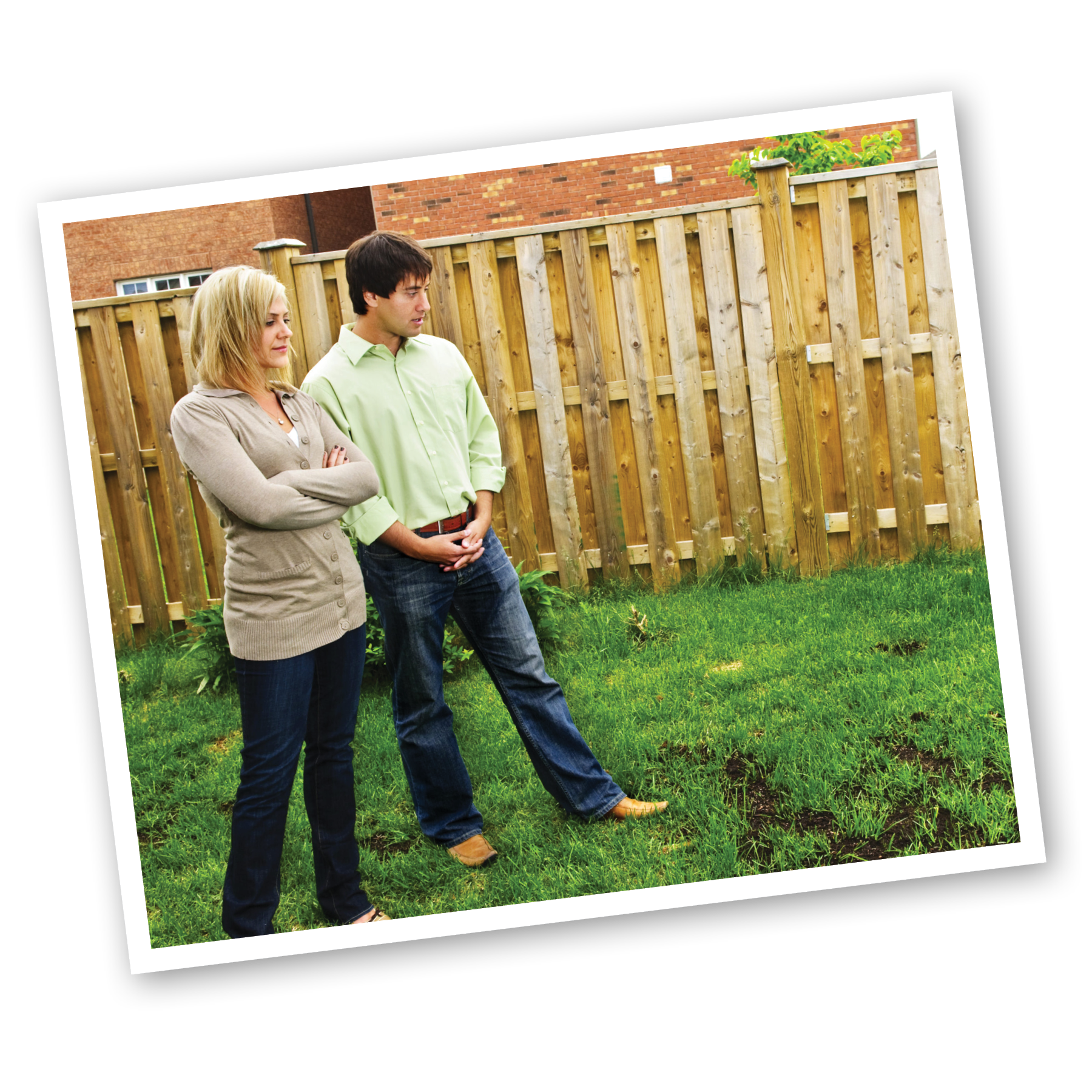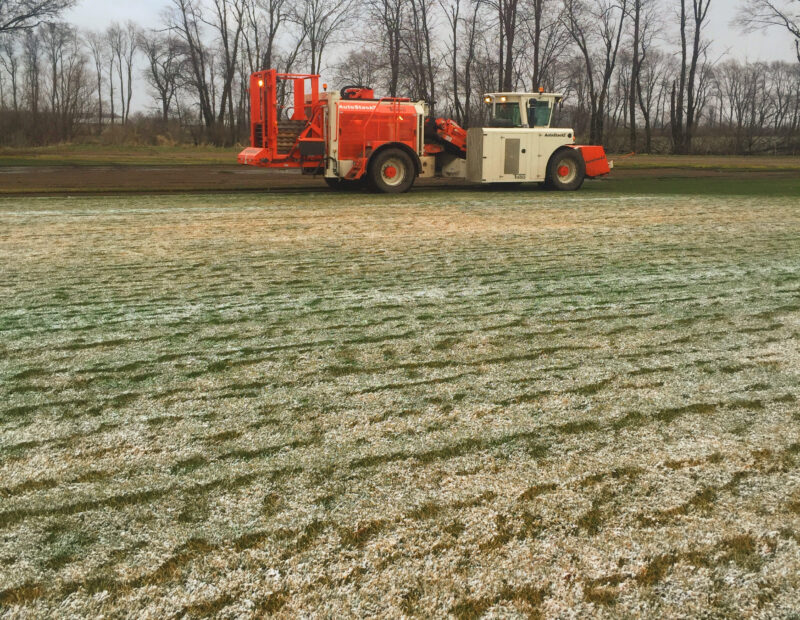
Poor looking grass in sunny areas is the result of the plants being stressed. The action that you take will either cause stress or relieve it. The trick is to find what is causing the plants to be stressed. Possible stressors are:
Fertility: Home lawns need three or more fertilizations per year to look good. If it has been four to six weeks since the last fertilizer was applied, another application is due. However, it is also important to avoid over applications too! Check out this article entitled, “Evaluating a Fertilizer Program,” to see if your current fertilizer application schedule is acceptable.
Mowing: Short, mowed turf has short roots. You should set your mower high– 2 ½ inches or more. Let the clippings lie, unless they are long and could smother the grass. Leaving the clippings does not cause thatch and does recycle nutrients to the lawn.
Watering: Are you watering properly? The only proper way to water is thoroughly but infrequently. Over watered lawns are shallow rooted, because air is cut off from getting to the roots. You cannot properly water a lawn by setting a timer for weeks or months at a time. For more information, view this article entitled “Effects of Over watering a Lawn.”
Insects: Grubs can eat the roots of turf, and are an easy problem to check for. Just grab the turf and pull up; then, look at the surface, and a little below the surface, for white worms. Grubs are usually only a problem in May, August and September. You may want to treat your lawn for grubs if you find more than 5 per square foot. Purdue University’s Turfgrass Science division has a great article on the topic of Grubs in Lawn that you can check out by clicking here.
Temperature and humidity: Cold temperatures in the fall and spring reduce leaf growth. Cold temps in winter, especially when there is no snow cover, often turn leaf tips brown. When the grass grows in the spring, the brown tips soon disappear. High temperature in the summer stresses the turf and slows the growth. Proper irrigation will lessen this stress. A week of high humidity at night is perfect for disease development. An overall good turf care program, and the use of disease resistant varieties, is the only preparation for this condition.
Disease: Prevention–by mowing, watering, and fertilizing properly–is the best cure for lawn disease. If you follow proper prevention techniques, you will seldom have a disease severe enough to require renovation of the lawn, unless, you have grass with inferior genes. Lawn diseases do occur, and the first instinct most homeowners have is to apply a fungicide. This approach is wrong because in most cases, the fungicide needs to be applied before the outbreak occurs. By the time the symptoms are seen, it is too late to apply a fungicide. Homeowners applying fungicides seldom see results worth their time, effort or expense. The more practical approach is to view a disease as a symptom of stressed turf, and work to correct the causes of the stressed turf. Newer grass varieties have improved genetics that lessen the severity of devastating diseases.
Genetics: If you do a good job of caring for your lawn and it still does not look as good as you want it to, maybe the grass lacks the genetic potential to look good. There are hundreds of grass varieties, and they do not all look or cost the same. Red Hen Turf Farm uses Kentucky bluegrass because it has the greatest potential to look good, out of all the suitable grasses for this area. Replacing a poor quality lawn with a better lawn is expensive. It is better to start out with the best possible genetics.
Diagnosing lawn problems is not that hard — you just need to observe the turf, and understand some basics about turfgrass physiology and the impact of the environment.

Poor looking grass in sunny areas is the result of the plants being stressed. The action that you take will either cause stress or relieve it. The trick is to find what is causing the plants to be stressed. Possible stressors are:
Fertility: Home lawns need three or more fertilizations per year to look good. If it has been four to six weeks since the last fertilizer was applied, another application is due. However, it is also important to avoid over applications too! Check out this article entitled, “Evaluating a Fertilizer Program,” to see if your current fertilizer application schedule is acceptable.
Mowing: Short, mowed turf has short roots. You should set your mower high– 2 ½ inches or more. Let the clippings lie, unless they are long and could smother the grass. Leaving the clippings does not cause thatch and does recycle nutrients to the lawn.
Watering: Are you watering properly? The only proper way to water is thoroughly but infrequently. Over watered lawns are shallow rooted, because air is cut off from getting to the roots. You cannot properly water a lawn by setting a timer for weeks or months at a time. For more information, view this article entitled “Effects of Over watering a Lawn.”
Insects: Grubs can eat the roots of turf, and are an easy problem to check for. Just grab the turf and pull up; then, look at the surface, and a little below the surface, for white worms. Grubs are usually only a problem in May, August and September. You may want to treat your lawn for grubs if you find more than 5 per square foot. Click here to find specific information about grubs.
Temperature and humidity: Cold temperatures in the fall and spring reduce leaf growth. Cold temps in winter, especially when there is no snow cover, often turn leaf tips brown. When the grass grows in the spring, the brown tips soon disappear. High temperature in the summer stresses the turf and slows the growth. Proper irrigation will lessen this stress. A week of high humidity at night is perfect for disease development. An overall good turf care program, and the use of disease resistant varieties, is the only preparation for this condition.
Disease: Prevention–by mowing, watering, and fertilizing properly–is the best cure for lawn disease. If you follow proper prevention techniques, you will seldom have a disease severe enough to require renovation of the lawn, unless, you have grass with inferior genes. Lawn diseases do occur, and the first instinct most homeowners have is to apply a fungicide. This approach is wrong because in most cases, the fungicide needs to be applied before the outbreak occurs. By the time the symptoms are seen, it is too late to apply a fungicide. Homeowners applying fungicides seldom see results worth their time, effort or expense. The more practical approach is to view a disease as a symptom of stressed turf, and work to correct the causes of the stressed turf. Newer grass varieties have improved genetics that lessen the severity of devastating diseases.
Genetics: If you do a good job of caring for your lawn and it still does not look as good as you want it to, maybe the grass lacks the genetic potential to look good. There are hundreds of grass varieties, and they do not all look or cost the same. Red Hen Turf Farm uses Kentucky bluegrass because it has the greatest potential to look good, out of all the suitable grasses for this area. Replacing a poor quality lawn with a better lawn is expensive. It is better to start out with the best possible genetics.
Diagnosing lawn problems is not that hard — you just need to observe the turf, and understand some basics about turfgrass physiology and the impact of the environment.

Updated 12/5/25
Red Hen Turf Farm’s
2025 Sod Harvesting Season
has OFFICIALLY ENDED
as of 12/5/25
due to SNOW / Precipitation and Unfavorable Field Conditions.
We had hoped to keep going until 12/19/25, but Mother Nature did not get that Memo, apparently :)
* * *
If you’re reading this in early 2026 and wonder when we might start back up again, a quick call will confirm our
SOD HARVEST FORECAST
– 574-232-6811 –
is the number to call.